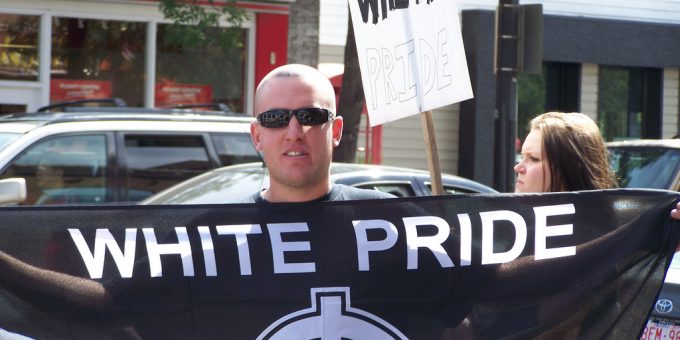
An "Aryan Guard" member protesting at an anti-racist rally in Alberta, Canada, 2007. Robert Thivierge / FlickrCC
The [Un]Surprising Alt-Right
The night that Barack Obama was elected President in 2008, the White supremacist web forum Stormfront lit up with posts about racial extremists’ fantastical visions of violence to combat “White racial genocide.” On election night 2016, Stormfront lit up again as White supremacists expressed triumph with Donald Trump’s victory. They celebrated: “We finally have one of us in the White House again!”
Since the election, observers have tried to explain the sudden rise of the so-called alt-right, but to those who track the far right, there’s nothing sudden about it. Long before election night, White supremacists had become savvy at outwardly masking their real beliefs and intentions while most wrote them off as politically innocuous wackos. Having bided their time, they are reemerging to try to capitalize on a racially recharged political climate.
The collective surprise at White supremacists’ arrival on the national stage reflects a lack of attention to the varied and persistent forms of racial extremism that have long simmered in America. Since their heyday in the mid-1920s through the Civil Rights era, white-hooded Ku Klux Klansmen have stood as the timeworn face of White supremacy. In the 1980s, neo-Nazi skinheads fused a racist ideology and a punk youth aesthetic with visions of a global Aryan movement. Their militant public displays drew new attention, along with strong challenges from authorities and anti-racist groups.
Facing a mainstream culture that vilified racial extremism, White supremacists gradually withdrew from most public forms of activism. Movement leaders told their followers to avoid repression by limiting overt displays of their allegiance. Thus, many racial extremists began living double lives: they covered their racist tattoos, grew out their hair, hid extremist insignia, and outwardly projected an image that concealed their beliefs. Leaders also encouraged them to infiltrate institutions to secure influence. For instance, the FBI has watched White supremacists quietly maintain an active presence in police departments and other law enforcement agencies, while others nurtured their hatred in seemingly benign, everyday settings such as family homes, Bible study meetings, and local bars. They found sanctuary on the Internet, embracing concealment as a savvy survival strategy. As leaders advocated lone-wolf attacks to spark a “race war,” White supremacist activism morphed into a mostly veiled struggle to withstand integrationist forces.
Some racial extremists also worked to reframe their rhetoric to appeal to mainstream conservative Whites. To neutralize the public stigma associated with White supremacy, they recast racial and anti-Semitic hatred as “White heritage preservation,” “White nationalism,” and, most recently, “the alt-right.” This sanitized “white-collar supremacy,” as religious historian Kelly J. Baker calls it, casts Whites as minority victims facing reverse discrimination. Their rebranded White supremacy aligns with broader populist conspiratorial anxieties about demographic change, immigration, and governmental overreach pushed by far-right pundits and networks of militia, sovereign citizens, nativists, Patriots, Tea Partiers, Oathkeepers, and Birthers.
We must be clear: White supremacists beliefs have not changed. They only hope to create a softer veneer for their virulent racial and anti-Semitic hate. As the ADL notes, the neo-Nazi National Socialist Movement, recently declared a ban on the swastika as a cosmetic overhaul intended to rebrand their look, draw in patriotic White Americans, and secure political power. These efforts are nothing more than a ploy to disguise the worst form of racial extremism.
We must also come to terms with the very real dangers racial extremism poses. For generations, White supremacy has spawned terror. Lone wolves like Dylan Roof lash out, believing they can save White America. For his part, Roof was directly inspired by the Council of Conservative Citizens’ “cleaned up” and rebranded White nationalism, which many observers thought would not motivate violence. The post-election wave of racial and ethnically charged crimes reflects a new boldness among racists and anti-Semites. But, if they do not attain the political power they feel entitled to during Trump’s presidency, we may still reasonably fear more extreme violence from those frustrated by the limits of institutional politics.
Robert Futrell is a sociologist at the University of Nevada, Las Vegas, and Pete Simi is a sociologist at Chapman University. Together, they are the authors of American Swastika.
[Note: This article was published in the Spring, 2017 print issue of Contexts.]

Comments 1
Timothy zaal
August 19, 2017Spot on target!